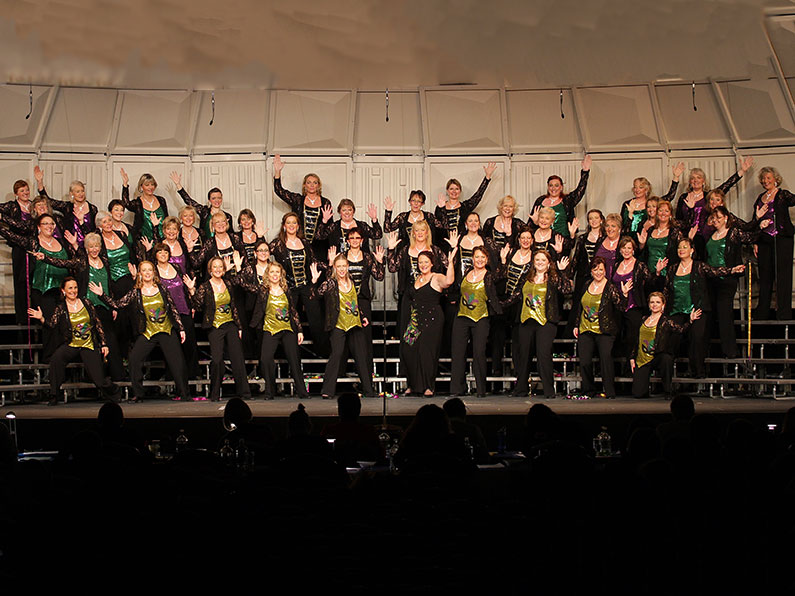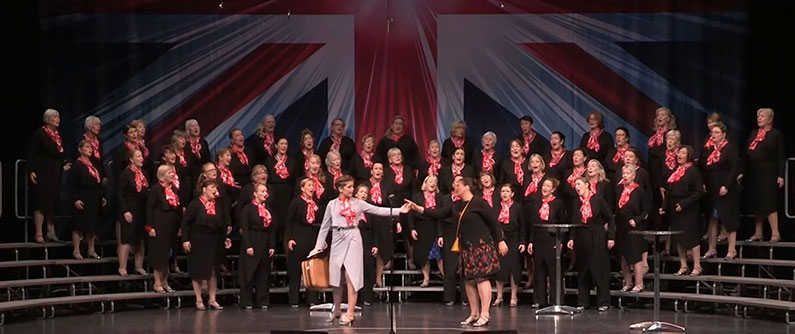Making your performance authentic
Fascinating Rhythm has a diverse repertoire of show tunes, popular modern songs and jazz numbers, and a few seasonal and sacred songs and even a vocal version of a ballet movement!
Some of our show songs are fully choreographed, all-singing-all-dancing numbers, whereas our ballads are much more sensitive and heartfelt. Whatever we’re singing, we want to connect with our audiences and give them an entertaining musical experience.
Our fabulous Assistant Director, Wendy, is also our chorus Choreographer. With a dance and percussion background, Wendy is inspiring, enthusiastic, and always encouraging us to make our performances more believable and engaging. Here are her top tips for authenticity:
Performance matters
Barbershop singing has a strong visual element and iconic four-part a cappella harmony, and the way we perform songs is a key aspect of our craft.
Performance is about ‘giving life’ to a song – making it believable and entertaining. Performances can be creative and dynamic, but they must match the song’s vocal message, and all singers should present a unified message about the song’s meaning.
As explained by the Ladies Association of British Barbershop Singers (LABBS) “The Performance Judge is hoping to see and hear sincere, from the heart performances into which […] the audiences are drawn.”
Getting ready to sing
Over the past few years, the barbershop world has moved towards a musical theatre performance style, inspired by David Brunetti’s ‘Acting Songs’ approach. In musical theatre, songs form part of the story; they help with the storytelling and flow in and out of the actors’ spoken performances.
However, when Fascinating Rhythm stands on stage to sing a song as part of a concert or a variety show, we perform without a storyline. To give an authentic performance, we must connect with the story behind the song we’re about to sing. If we understand the song’s essence, we should all give the same heartfelt performance.
We can do this by thinking about three things:
1. Who are you as the person singing this song?
2. Why are you singing this song – what is it about?
3. What has just happened – why are you singing this song now?
What are you singing about?
One way to really understand a song is to read the lyrics aloud as if they were a monologue. In barbershop-style arrangements, the lyrics are usually found in the Lead line, with the harmony parts (Tenor, Baritone and Bass) picking up more melodic aspects of the music. It can be hard to connect with the meaning of a song if you’re singing ‘dm-dm-dm’ or ‘ooh-ooh’ rather than words! But if every member of the chorus knows the story behind the song, we can all connect with it.
What if the song doesn’t have a clear storyline? How can we connect with it and give an authentic performance? If lyrics don’t drive a song, it can be tricky to connect with its meaning, but we can instead focus on the musical elements.
Songs usually fit into one of five themes, according to the strongest element of the arrangement.
– Lyric songs are driven by the words or the story being told
– Melodic songs have a strong tune (usually in the Lead line)
– Harmonic songs feature the chord structure of the music
– Rhythmic songs are all about the beat, and they make you want to dance or tap your feet
– Comedy or novelty songs are funny!
Our performance journey
Fascinating Rhythm is known for bold and innovative performances and bringing new bespoke arrangements to the LABBS Convention stage. Over the years, we’ve put full choreography, and dance moves to up-tempo numbers and even added streamers and party-poppers to the final bars of South Rampart Street Parade! We’ve also experimented with the ‘fourth wall’ in on-stage performances and tried standing completely still to add tension to sacred songs and tragic ballads.
“Meet You At The Moon” (Harrogate, 2018), arranged by Liz Garnett, had an easy storyline that we all connected with. Subtle chorus moves from the risers complemented the mother-daughter story featuring Jo and Karen. It was effective and authentic because every member of the chorus could draw on their own personal experience of familial love and sing from the heart.
In contrast, “You Don’t Own Me” (Bournemouth (2017), also arranged by Liz Garnett, was a strong and sassy up-tune with great choreographic moves. The romantic ballad “City of Stars” (Llandudno, 2019), another fabulous Liz Garnett arrangement, had a surprise free-feeling rhythmic section in the middle that naturally lent itself to more dance-like movement.
Although we can’t take a competition package to the Convention this year, we have two fantastic songs lined up, ready to work on once we’re allowed back to rehearsals. We’re making good use of our Zoom rehearsals to immerse ourselves in the lyrics so that we can develop a truly authentic performance to enhance our singing and musicality.
Putting authenticity into practice
The great thing about authenticity is that you can practice it anytime, anywhere – even if you’re singing alone at home! Whatever the song you’re rehearsing, spend a minute before you sing thinking about who you are, why you’re singing the song, and what has just happened to make you sing it. The main thing is to try to really connect with the song and the music and sing it from the heart. Even focusing on one of these questions will enhance your performance authenticity.
You might like to see other articles in the Fascinating Rhythm Insights series:
01 – Why Singing is Good For You
03 – Enhancing Performance Through Expression
04 – Teamwork Makes the Dream Work
05 – Why Warm Up?
06 – The New Members Guide to Joining a Choir During a Pandemic!
07 – Breathing to Sing
08 – Junior FR: how it started / how it’s going
09 – Singing is a Family Affair
10 – How we choose Convention songs
11 – Mixing it Up
12 – Love to Sing



